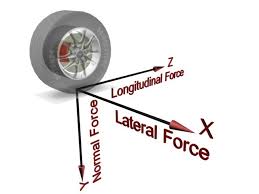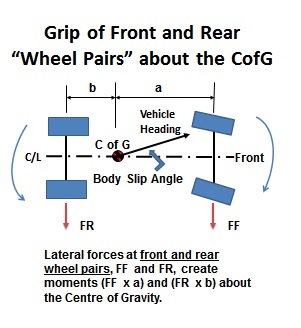It's All About Grip and Balance


Our course, "Every Racers Guide to Suspension Tuning", includes showing you how handling works. As an example, this simple diagram is the basis for describing what's behind the Weight Transfer Worksheet™, leading to our simple definitions for oversteer and understeer.
The Moment of a Force is a measure of its tendency to cause a body to rotate about a specific point. Our diagram shows the top view of a car in a corner. The forces FF and FR create moments about the Centre of Gravity. Note also the Body Slip Angle, the difference between the heading of the vehicle and the vehicle centre line. We give you a complete "heads up" on how the body slip angle happens due to the slip angles at the tyre contact patches.
Front and Rear "Wheel Pairs" - Tyre Grip
You’ve probably heard the phrase “the only thing between you and the road is the four tyre contact patches”, or similar. Not that insightful. In fact, it’s pretty darned obvious.

But here is a more profound statement about tyres from Damien Harty, a leading expert in Handling. He is a Vehicle Dynamics Engineer and Author:
“The only things that matter in Vehicle Dynamics are the forces on the tyres.”
Damian Harty.
Longitudinal force, Z, braking and acceleration, and lateral force of cornering, X, vertical load, Y shown.
Even so, there is still complexity. Variable tyre loadings, differing co-efficients of friction at each tyre, lateral weight transfer influencing vertical load etc etc.
Then how about this as a basis for simplifying what’s happening...

We combine the grip of each individual wheel and tyre into the grip of front and rear wheel pairs. The lateral force for each wheelpair “FF” and “FR” is shown in the diagram.
The car turns (changes direction) about its Centre of Gravity. The moments (FF x a) and (FR x b) are rotating the car in opposite directions.
In steady state, the moments are balanced, and there is no change to yaw rate (or turning) of the vehicle. No change in the Body Slip Angle.
"Steady state" implies fixed steering position, fixed throttle, such as driving at constant speed in a circle. In most corners on a race track it only happens for a very short time, and is referred to as "mid corner" - the transition from corner entry to corner exit.
Cornering in steady state is the simple premise for the weight transfer calculations in the Weight Transfer Worksheet™..and leads to our simple definitions of understeer and oversteer.
Here's another quote from Damien Harty...(yaw rate is simply turn rate)
He is describing the corner entry and corner exit phases...
“The need for a Body Slip Angle gives rise to an additional yaw rate, rotating the body to the expected body slip angle, for a brief period near the start of any manoeuvre. There is also a corresponding yaw rate reduction at the end of a manoeuvre required to bring the vehicle back to its trimmed, straight-ahead state.”
The racing driver is highly sensitive to the change in Body Slip Angle (the Body Slip Rate.) In circuit racing, the driver operates the car in a rehearsed way such that the body rotates to the drivers expected body slip angle. In so doing, the driver is not feeling the actual value of the body slip angle, only the body slip rate.
The skilled racing driver uses all the available tyre grip. So his/her expected body slip angle is analagous to the maximum steady state body slip angle that is achieved mid corner.
Body slip angle is a function of the tyre slip angles. The tyre designers build in the tyre slip angles they want, so as to achieve their overall objectives for tyre performance.
So here are our definitions of understeer and oversteer....
Oversteer is Body Slip Angle building faster, such that the angle at any instant in time is greater than expected by the driver.
Understeer is Body Slip Angle building slower, such that the angle at any instant in time is less than expected by the driver.
We have much more in "Every Racers Guide to Suspension Tuning"....
Along the lines of this article, we have "closed the loop" in our understanding of what happens from first response to inputs at the tyre contact patch through to the drivers perception of understeer/oversteer.
If you havn't seen our free training videos, opt-in below.

